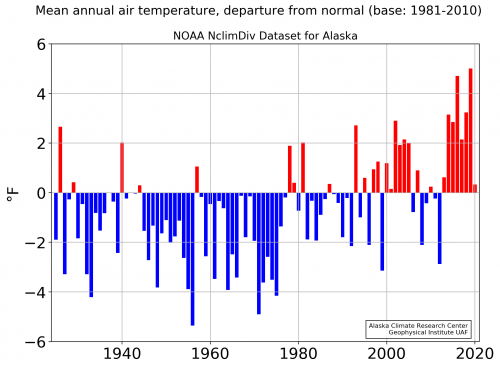In preparing my Changing Climate post, I read again my prior climate change posts and thought one deserved an update. In a 2015 post, Controlling The Narrative: Climate Change, I took a Washington Post science writer to task for a misleading article linking forest fires in Alaska to climate change, in the course of which he mischaracterized the data on temperature increases in that state.
I knew the article was incorrect the moment I read it because, since the early 2000s, I'd been following Alaska climate trends via the website of the Alaska Climate Research Center (ACRC) of the University of Alaska. That had been prompted by a misleading article in the New York Times about Alaska climate trends.
In both cases, the newspaper narrative used convenient start and end dates to support its claims. I've seen these tactics used by both climate change alarmists and self-proclaimed debunkers. Always look beyond the start and end dates to see if trends change. You can read the linked post for more detail on why the WaPo article was misleading and learn about the Pacific Decadal Oscillation (PDO).
However, it is another part of the post that requires an updating as I've continued to occasionally check in on the ACRC. In the 2015 post I noted:
I have one observation of my own regarding the ACRC data. On the second chart, notice that Barrow — which lies on the Arctic Ocean, much further north than the other Alaska weather stations — has noticeably warmed since 1976 in contrast to the rest of the state. Carbon dioxide greenhouse gas warming theory predicts that the greatest temperature increases will initially be seen in the Arctic and Antarctic, so the Barrow data is intriguing. I’m not familiar with temperature trends in other areas of the Arctic, so can’t tell you whether this change is due to a local anomaly or is part of a broader trend. However, in the Antarctic there is no warming trend, with the exception of the Antarctic peninsula which extends farther north than the rest of the continent. It’s something I’d like to know more about but won’t trust anything Mooney [author of the WaPo article] might write about it.
I like predictions that can be falsified. Unfortunately, too many climate claims can't be. More rain than normal? Climate change! Less rain than normal? Climate change! Less snow than normal? Climate change! More snow than normal? Climate change! The list goes on and on. But the prediction for larger temperature increases at the poles can be falsified.
It turns out that since 2015, the warming trend at Barrow (now called Utqiagvik) has not only continued, but accelerated. From 1949 through 2020, the town's annual temperature has increased by 7.5 degrees, and by 10 degrees in the winter. The annual increase is almost 2 degrees more than any other town in the state and almost twice the average increase for the entire state.
The change is even more dramatic if measured from 1976. During this period, average state temperature increased by 3.3 degrees but Utqiagvik has increased 12.4 degrees, including by nearly 20 degrees in the autumn and 13 degrees in the spring. As mentioned in the 2015 post, I have not conducted detailed research on Antarctic data or on other Arctic regions, but the Utqiagvik data is consistent with warming theory. The ACRC notes that temperature increases have been the highest across the regions closest to the Arctic Ocean:
The most significant temperature increases have occurred along the North Slope, the Arctic Coast, and the adjacent Arctic Ocean from the Beaufort to the Chukchi Sea.
These same years since 2015 have also shown a continued elevated temperature increase across the state as shown in this ACRC chart:

The ACRC has this note regarding the above chart:
The stepwise shift appearing in the temperature data in 1976 corresponds to a phase shift of the Pacific Decadal Oscillation from a negative phase to a positive phase. Synoptic conditions with the positive phase tend to consist of increased southerly flow and warm air advection into Alaska during the winter, resulting in positive temperature anomalies.
Changes in the PDO have major impacts on Alaska weather, and it is unpredictable when it next changes to a negative phase in which it brings cold air advection into the state. However, the northerly parts of the state which have seen the greatest temperature increases in recent years may be the least impacted region by a change in the PDO.
No comments:
Post a Comment